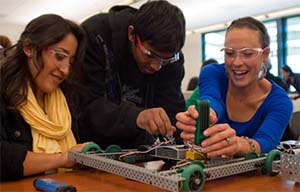INNOVATIVE TEACHING SHOWCASE
IDEAS
Idea 4: Project-Based Learning
“In Project-Based Learning, students are active, not passive; a project engages their hearts and minds, and provides real-world relevance for learning.”2
Learning Intention
Project-based learning is a strategy for implementing inquiry-based learning that engages students in creating a product or solving a problem as a path for learning for course concepts as well as important success skills such as critical thinking, collaboration, and communication.2 Project-based learning can be implemented in any discipline, from music to math, art to science, business to education.
 Overview
Overview
Faculty structure a learning experience for students that begins with a problem or question and asks students to take ownership of gathering resources and working (together or individually) to solve the problem, develop a proposal, or answer a question. Music students might work toward creating a movie trailer soundtrack3; art students might develop an art exhibit or museum installation for campus; business students might propose a marketing strategy for on-campus student services; engineering students might solve an accessibility problem on campus. “Projects provide students with empowering opportunities to make a difference, by solving real problems and addressing real issues.”2
Instructions
- Entry Event: “Activate students’ need to know content by launching a project with an [engaging story or event that will pique] interest and initiate questioning.”4 You might use actual news articles, film clips, song lyrics, or hypothetical scenarios to draw students in and then connect the story to their own experiences.
- Driving Question: Collaborate with students to narrow the focus of the problem from the story or event. Identify an abstract or concrete question to answer, a project or product to build, or a problem to be solved. “A good driving question captures the heart of the project in clear, compelling language, which gives students a sense of purpose and challenge.”4
- Student Voice and Choice: Give students as much decision-making power as they are capable of in choosing how to tackle the project and what artifacts they will produce to showcase their learning.3,4 An instructor might narrow the choices to a menu of options or give students leeway to determine what they will create.
- Sustained Inquiry and Innovation: Facilitate students’ quest to find resources (textbooks, websites, articles, books, and experts or organizations) to discover answers, inform new questions, and apply course concepts to solving a problem or completing a project. Scaffold activities and build formative steps for entry-level learners by narrowing the range of materials.3
- Feedback & Revision: Timely feedback is essential to keep students moving in the right direction toward learning outcomes.3 Peer critique, rubrics, and rough drafts of proposals or products can all be useful, especially if used together.4
- Publicly Presented Product: Include opportunities for reflection and sharing, not only with each other but with members of the community as well.3,4 Not only will this solidify learning for students, it will reinforce the value of the project and instill a sense of pride in their work.4
Considerations
- Real-world relevance is key to student ownership and success in project-based learning.3 Not only should the question driving the project be authentic, so should the tasks and tools for solving the problem.1
- Invest in establishing a supportive classroom culture that values questioning and openness to new ideas and perspectives so that students will feel safe to take the intellectual risks necessary to explore and make mistakes.4
References
- Buck Institute for Education (no date). What is Project-Based Learning?
- Buck Institute for Education (no date). Why Project-Based Learning?
- Hayden, M. (2016). Personalized Learning Through Project-Based Music. National Assocation for Music Education website. Available online.
- Larmer, J. & Mergendoller, J. R. (2010). Seven Essentials for Project-Based Learning. Giving Students Meaningful Work, 68 (1), pp. 34-37. Available online.


